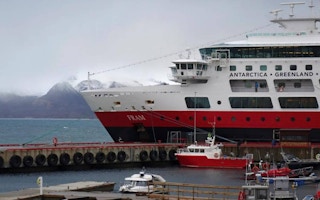A lust for adventure tourism is driving a rise in the number of cruise ships touring the Arctic, but local people are not seeing the benefits, experts said on Tuesday, after an explorer raised fears over “party ships” in the region.
Indigenous communities are being “overwhelmed” by ships that drop up to 1,000 passengers in small villages but offer no employment opportunities, said Kuupik Vandersee Kleist, an advisor to the Inuit Circumpolar Council.
“They don’t leave much value behind them,” he told the Thomson Reuters Foundation.
“They arrive with their own guides. Villagers might be able to sell a little bit of local art—bone carvings or driftwood, but that is not sufficient to balance the harm they are doing.”
The Association of Arctic Expedition Cruise Operators, which represents small expedition cruises, said it was dedicated to responsible tourism and liaised closely with local communities.
“
Some of the small Inuit villages are literally flooded with passengers who only look and give little back to local people. It’s usually only the visitors who benefit—not the residents.
Arved Fuchs, German adventurer
“Many Arctic communities welcome the opportunities associated with increased tourism,” said executive director Frigg Jorgensen.
The number of global ocean cruise passengers rose from 17.8 million in 2009 to 28.5 million in 2018, according to research by the Cruise Lines International Association, an industry body.
It found passengers increasingly sought access to destinations that were previously out of reach.
German adventurer Arved Fuchs this week raised concerns over the growing number of large cruises in the Arctic.
“Some of the small Inuit villages are literally flooded with passengers who only look and give little back to local people. It’s usually only the visitors who benefit—not the residents,” he told German Neue Osnabrücker Zeitung newspaper.
Large cruise ships also carry a heavy environmental burden, according to the Friends of the Earth charity, which said the vessels created large amounts of human sewage, oily bilge water and hazardous waste.
Tero Vauraste of the Arctic Economic Council, which promotes responsible development, said the number and size of cruise ships in the region had increased with more than 100,000 passengers now arriving each year.
In Canada, cruise ships carrying more than 1,000 people have been going through the North West Passage over the last three or four years, and their approach to indigenous communities has been “contradictory”, he said.
“It creates an opportunity for new and additional livelihoods for the communities, but their opportunities to receive hundreds of guests within a day or two are really restricted so it has been problematic,” he said.
However, he also said there were examples of good practice, especially around the Greenland and Svalbard area, with ships imposing strict rules when entering indigenous areas and even organising litter picks of rubbish washed ashore.
This story was published with permission from the Thomson Reuters Foundation, the charitable arm of Thomson Reuters, that covers humanitarian news, women’s and LGBT+ rights, human trafficking, property rights, and climate change. Visit http://news.trust.org.

















